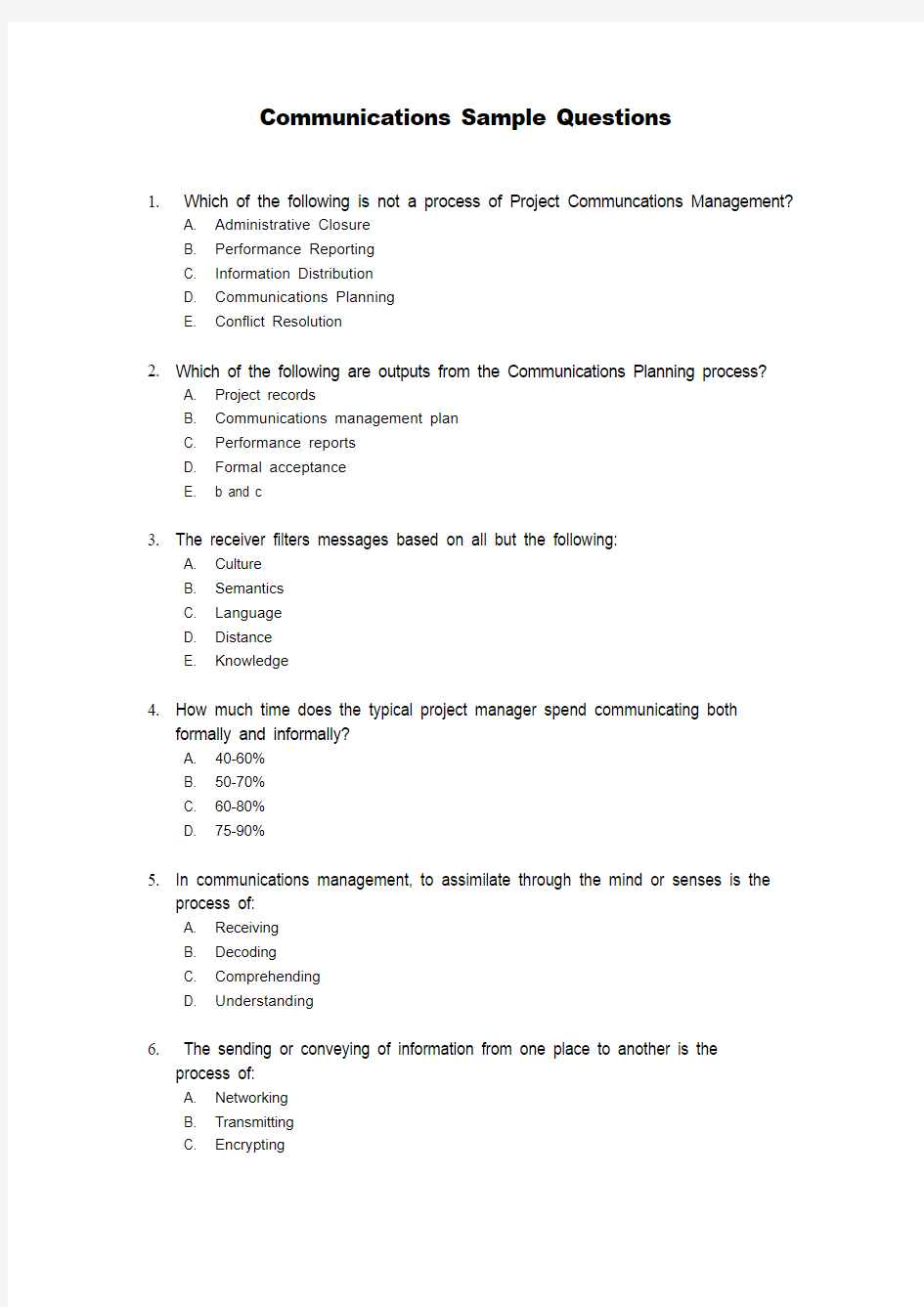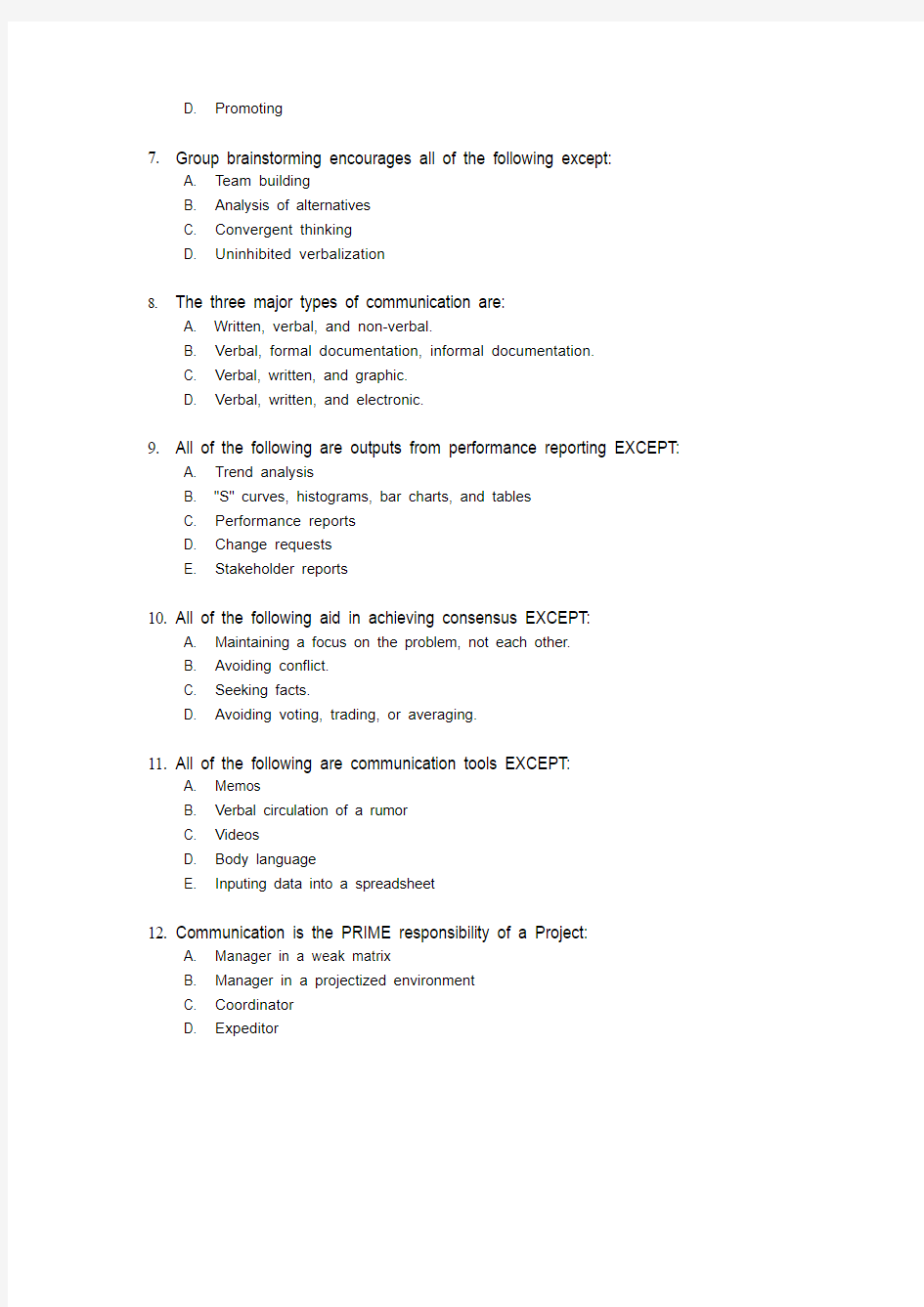

Communications Sample Questions
1.Which of the following is not a process of Project Communcations Management?
A. Administrative Closure
B. Performance Reporting
C. Information Distribution
D. Communications Planning
E. Conflict Resolution
2.Which of the following are outputs from the Communications Planning process?
A. Project records
B. Communications management plan
C. Performance reports
D. Formal acceptance
E. b and c
3.The receiver filters messages based on all but the following:
A. Culture
B. Semantics
C. Language
D. Distance
E. Knowledge
4.How much time does the typical project manager spend communicating both
formally and informally?
A. 40-60%
B. 50-70%
C. 60-80%
D. 75-90%
5.In communications management, to assimilate through the mind or senses is the
process of:
A. Receiving
B. Decoding
C. Comprehending
D. Understanding
6.The sending or conveying of information from one place to another is the
process of:
A. Networking
B. Transmitting
C. Encrypting
D. Promoting
7.Group brainstorming encourages all of the following except:
A. Team building
B. Analysis of alternatives
C. Convergent thinking
D. Uninhibited verbalization
8.The three major types of communication are:
A. Written, verbal, and non-verbal.
B. Verbal, formal documentation, informal documentation.
C. Verbal, written, and graphic.
D. Verbal, written, and electronic.
9.All of the following are outputs from performance reporting EXCEPT:
A. Trend analysis
B. "S" curves, histograms, bar charts, and tables
C. Performance reports
D. Change requests
E. Stakeholder reports
10.All of the following aid in achieving consensus EXCEPT:
A. Maintaining a focus on the problem, not each other.
B. Avoiding conflict.
C. Seeking facts.
D. Avoiding voting, trading, or averaging.
11.All of the following are communication tools EXCEPT:
A. Memos
B. Verbal circulation of a rumor
C. Videos
D. Body language
E. Inputing data into a spreadsheet
https://www.doczj.com/doc/b87151074.html,munication is the PRIME responsibility of a Project:
A. Manager in a weak matrix
B. Manager in a projectized environment
C. Coordinator
D. Expeditor
13.A tight matrix is:
A. A balanced matrix organization.
B. Where all team members are brought together in one location.
C. Where functional managers operate in a dual reporting structure reporting to both
their own departments and to the project manager.
D. a and c
14.The sender is responsible for:
A. Confirming the message is understood.
B. Ensuring the receiver agrees with the message.
C. Scheduling communication exchange.
D. Presenting the message in the most agreeable manner.
15.What are the four parts of the communications model?
A. Sending, Receiving, Decoding, and Comprehending
B. Sender, Message, Medium, Receiver
C. Communicator, Message, Receiver, Decoder
D. Communicating, Transmitting, Receiving, Comprehending
16.A leadership style in which the project manager shares problems with team
members and formulates solutions as a group is called:
A. Autocratic
B. Consultation in a group
C. Consensus
D. One-to-one consultation
17.In negotiating with functional department managers, project managers often find
themselves using what two-party conflict management approach?
A. Win-Lose
B. Win-Win
C. Lose-Lose
18.A type of organization in which the project manager has little formal authority and
basically acts as a staff assistant to an executive who is ultimately responsible for the project is called:
A. Functional
B. Weak matrix
C. Project coordinator
D. Project expediter
19.Formal acceptance by the client or sponsor of the project should be preapred and
distributed during which process?
A. Information Distribution
B. Administrative Closeout
C. Organizational Planning
D. Performance Reporting
20.In which of the following organizations is the project manager role likely to be
part-time?
A. Weak matrix
B. Functional
C. Balanced matrix
D. a and b
E. All of the above
Contract Sample Questions
1. A unilateral contract under which the seller is paid a preset amount per unit of
service is called:
A. A cost reimbursable contract
B. A lump sum contract
C. A unit price contract
D. A fixed price contract
E. b or d
2. Which of the following is considered during the Procurement Planning Process?
A.Whether to procure
B.How to procure and how much to procure
C.What and when to procure
D. b and c
E.all of the above
3. From a buyer's standpoint, which of the following is true?
A.Procurement planning should include consideration of potential subcontracts
B.Procurement planning does not include consideration of potential subcontracts since
this is the duty of the contractor.
C.Subcontractors are first considered during the Solicitation Process
D.none of the above
4. Which of the following processes involves obtaining information (bids and proposals) from prospective sellers?
A.Procurement Planning
B.Source Selection
C.Contract Administration
D.Solicitation
E.Solicitation Planning
5. Which of the following is true about procurement documents?
A.Procurement documents are used to solicit proposals from prospective sellers.
B.Invitation for Bid and Request for Proposal are two examples of procurement
documents.
C.Procurement documents should be structured to facilitate accurate and complete
responses from prospective sellers.
D. b and c
E.all of the above
Contract Sample Questions, cont.
6. Which of the following is a method for quantifying qualitative data in order to minimize the effect of personal prejudice on source selection?
A.Weighting system
B.Screening system
C.Selecting system
D.none of the above
E.all of the above
7. Which of the following is true concerning evaluation criteria?
A.Can often be found in procurement documents
B.Can be objective or subjective
https://www.doczj.com/doc/b87151074.html,ed to rate or score proposals
D.May be limited to purchase price if procurement item is readily available from
number of sources
E.all of the above
8. Which of the following are inputs to the Source Selection Process?
A.Evaluation criteria
https://www.doczj.com/doc/b87151074.html,anizational policies
C.Procurement documents
D. a and b
E.all of the above
9. A significant difference between independent estimates and proposed pricing could mean that:
A.The independent estimates are most likely incorrect and the proposed pricing correct
B.The SOW was not adequate
C.The prospective seller either misunderstood or failed to respond fully to the SOW.
D. b or c
E. a or c
10. Which of the following are examples of indirect costs?
A.Salaries of corporate executives
B.Salaries of full-time project staff
C.Overhead costs
D. a and b
E. a and c
11. Which of the following contract types places the greatest risk on the seller?
A.Cost-plus-fixed-fee contract
B.Cost plus-incentive-fee contract
C.Fixed-price-incentive contract
D.Firm-fixed-price contract
12. In which of the following contract types is the seller's profit limited?
A.Cost-plus-percentage-cost contract
B.Cost-plus-fixed-fee contract
C.Fixed-price-plus-incentive
D. b and c
E.none of the above
13. A cost-plus-percentage-cost (CPPC) contract has an estimated cost of $120,000
with an agreed profit of 10% of the costs. The actual cost of the project is
$130,000. What is the total reimbursement to the seller?
A.$143,000
B.$142,000
C.$140,000
D.$132,000
14. A cost-plus-incentive-fee (CPIF) contract has an estimated cost of $150,000 with
a predetermined fee of $15,000 and a share ratio of 80/20. The actual costs of
the project is $130,000. How much profit does the seller make?
A.$31,000
B.$19,000
C.$15,000
D.none of the above
15. A fixed-price-plus-incentive-fee (FPI) contract has a target cost of $130,000, a target profit of $15,000, a target price of $145,000, a ceiling price of $160,000, and a share ratio of 80/20. The actual cost of the project was $150,000. How much profit does the seller make?
A.$10,000
B.$15,000
C.$0
D.$5,000
16. Under what circumstances is it better for a contractor to subcontract?
A.The subcontractor possesses special technical and engineering skills that the contractor does
not have.
B.The work to be subcontracted represents almost all of the overall work effort.
C.The subcontractor can perform the work at a lower cost than the contractor.
D.all the above
E. a and c
17. Which type of bilateral contract is used for high dollar, standard items?
A.Purchase order
B.Request for proposal (RFP)
C.Invitation for bid (IFB)
D.Request for quotation (RFQ)
E.all of them are appropriate
18. Which of the following are characteristics of a purchase order?
A. A bilateral contract used for low dollar items
B. A unilateral contract used when routine, standard cost items are required.
C. A bilateral contract used for high dollar, standard items
D. a and c
19. In which stage of the negotiation meeting are points of concession identified?
A.probing
B.closure
C.agreement
D.scratch bargaining
20. Which type of warranty is enacted if a service or product does not meet the level
of quality specified in the contract?
A.Implied warranty of merchantability
B.Implied warranty of specified quality
C.Express warranty
D.none of the above